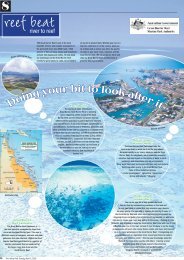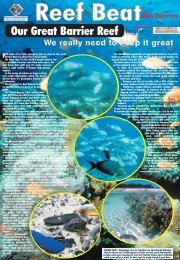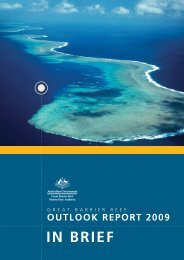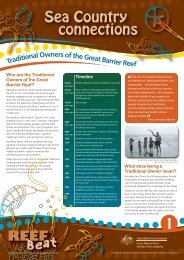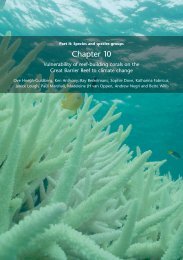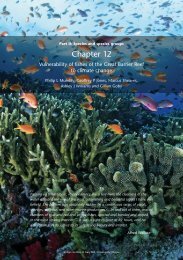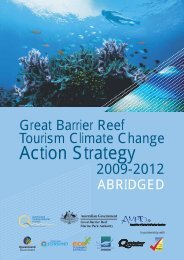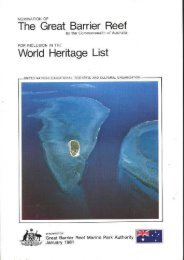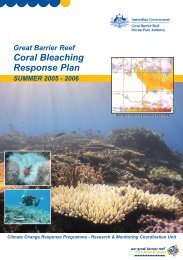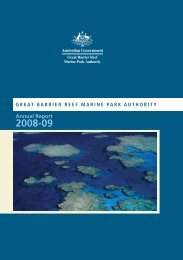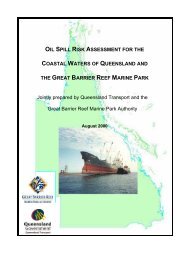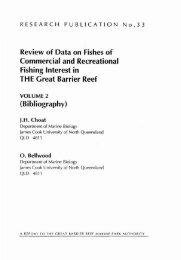ACTIVITIES BOOK - Great Barrier Reef Marine Park Authority
ACTIVITIES BOOK - Great Barrier Reef Marine Park Authority
ACTIVITIES BOOK - Great Barrier Reef Marine Park Authority
You also want an ePaper? Increase the reach of your titles
YUMPU automatically turns print PDFs into web optimized ePapers that Google loves.
1mWhat you will need:1. topographic map of yourtown (photocopied) or ourexample of a coastal town(maps for Townsville areprovided in the OtherResources folder)2. textas, pencils, orhighlighters in a rangeof coloursInstructions: Have studentslook at the map to determinelow lying areas. Theirexperiences should helpwith this. If the map isn’talready coloured, get thestudents to colour ineverything at or below sealevel (to illustrate wherewater currently exists). Thecontour lines on the mapindicate elevation. Using thebelow table of climatechange predictions from theIntergovernmental Panel onClimate Change (IPCC), askstudents to use differentcolours to indicate which areaswill be under water by 2020,2050, 2100 and in the moredistant future.4m4m2m2m1m1m1m2mA personal perspective: Have studentsconsider what this means to them and their town. What will happen toyour school or community if the ocean rises by one metre? Whathappens if this occurs in conjunction with king tides or a storm surgein your area? Flooding and severe weather are likely to increase withclimate change. Will this affect your findings? Can you find your homeon the map? When will your home be impacted by sea level rise?Table 1. Sea level rise projections if climate change continues at itscurrent rateProjected change 2020 2050 2100 Eventual sea level rise(when ice caps melt)Sea level rise 38 cm 68 cm 1 m 4-6 m**If climate change continues at its current rate, we could be committed to this 4-6 mrise by 2100. Based on palaeoclimatic evidence, however, this would take severalhundred years to occur completely (e.g. not until 2300 or later).Activity 2: Climate change futures wheelKey learning objective: Small changes in the climate can result inbig changes on the <strong>Reef</strong>. After completing this activity, students willdevelop an understanding of the flow-on effects of climate changewithin coral reef ecosystems.Background: Students should have a basic awareness about climatechange and its potential impacts on the <strong>Reef</strong>. They may have already readBright idea:The concept of partsper million (ppm) isimportant for studentsto understand how variousconcentrations of carbon dioxidewill affect our planet. This is adifficult concept to visualise. Thinkof a creative way to help studentsconceptualise ppm (e.g. one colouredgrain of rice in a million, one tree ina forest of a million, or one drop ofcoloured water in a million). Discussthe threshold levels of carbondioxide and other greenhouse gases(in terms of ppm) and theirpotential environmental impacts.See Poster 3 for images of whatthe <strong>Reef</strong> could look like undervarious concentrations of carbondioxide and ask students to conductmore specific research on howvarious ppm will affect coral reefs.8<strong>Reef</strong> Beat 2009 - Climate Change and the <strong>Reef</strong>



